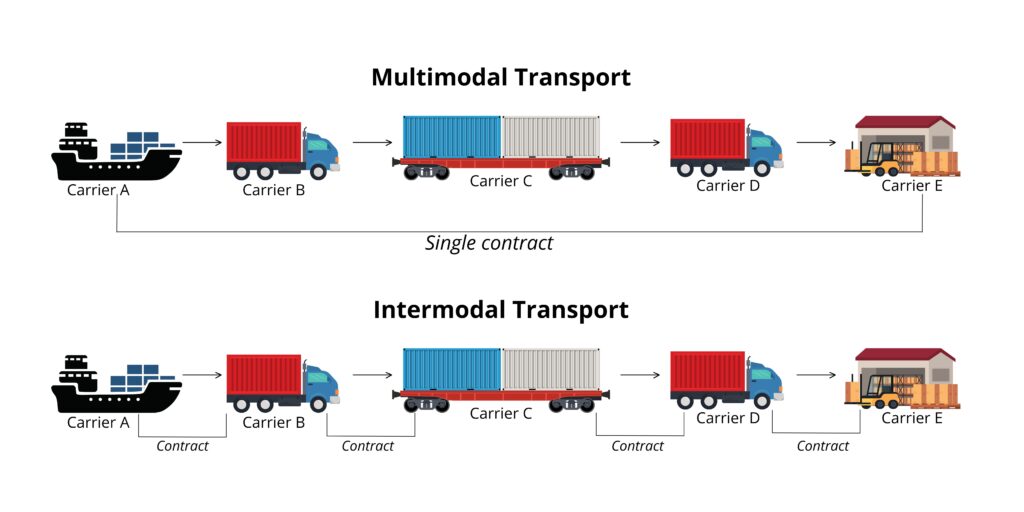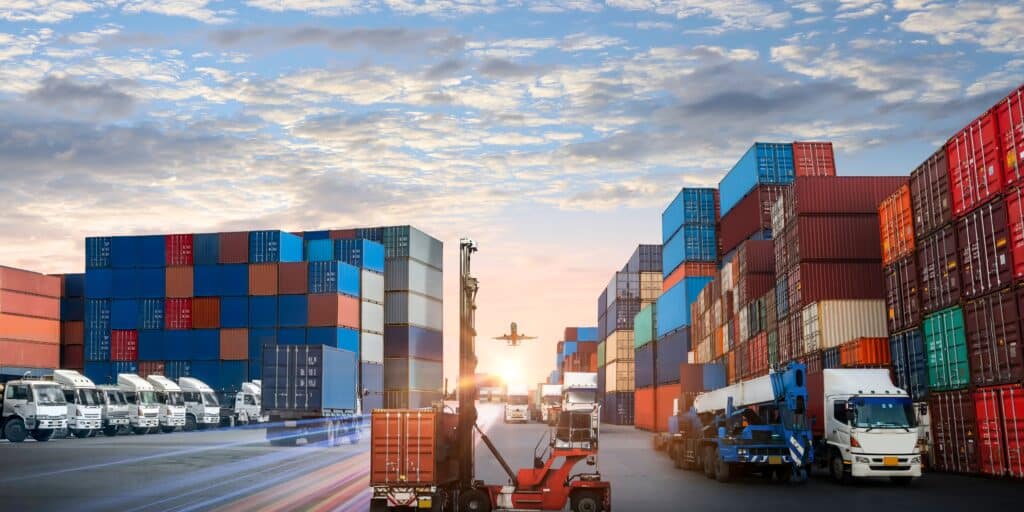Global trade relies on efficient transportation networks to move goods across vast distances. Two key logistics strategies, intermodal and multimodal transport enable seamless shipments using multiple transport modes, such as trucks, trains, ships, and airplanes. While they may seem similar, their fundamental difference lies in contract structure.
With the intermodal freight market projected to reach $72.51 billion by 2031, understanding these transport methods can help optimize supply chains, reduce costs, and improve efficiency. What are these two logistics methods, and how do they differ?
Understanding Intermodal and Multimodal Transport
Modern shipping gained momentum in the 1950s, thanks to the introduction of standardized shipping containers by Malcolm McLean, revolutionizing global trade. The Intermodal Surface Transportation Efficiency Act (ISTEA) of 1991 further enhanced intermodal logistics.
What is Intermodal Transport?
Intermodal transport is a logistics method that involves moving cargo using various transportation modes such as rail, road, air, and sea while keeping the shipment in the same container throughout the journey. Unlike multimodal, where a single contract governs the entire process, intermodal shipping requires separate agreements with different carriers for each leg of the journey.
This method of transporting goods encompasses two primary methods: Container-On-Flat-Car (COFC) and Trailer-On-Flat-Car (TOFC):
In COFC, goods are packed into standardized containers, which are then securely placed on flat railway cars, ensuring performance in handling various types of cargo. This advanced logistical concept is widely used for consumer goods, perishables, and industrial materials.
In TOFC, entire trailers or semi-trailers are loaded directly onto railcars, making it ideal for oversized or irregularly shaped shipments.
What is Multimodal Transport?
Managing shipments across multiple transport modes is complex, but multimodal transport simplifies it with a single contract. One logistics provider oversees the journey across rail, road, air, and sea, reducing administrative tasks. For example, a shipment from Los Angeles to Paris moves by truck to a rail terminal, then by train to an East Coast port, ships to Le Havre, France, and continues by rail and truck to Paris—all managed under one contract for seamless delivery.
Differences Between the Two Freight Solutions
When transporting goods, selecting the most efficient route for timely door-to-door delivery is essential. This is where the decision between intermodal and multimodal transportation becomes important. One of the main distinctions lies in the contract structure. In intermodal shipping, firms will need multiple contracts, one for each carrier handling a segment of the journey. In contrast, multimodal shipping operates under a unified agreement, simplifying logistics management.
Handling also varies between the two. In intermodal shipping, merchandise may require additional coordination at each landing point, increasing complexity. However, multimodal shipping offers advantages by streamlining operations, as a single provider oversees the entire journey.
For shippers, the choice depends on priorities. Businesses seeking flexibility and cost control may prefer intermodal shipping, while those prioritizing convenience may opt for multimodal.

How Can They Benefit and Challenge Your Business?
Every advantage has its price, and every disadvantage holds a hidden opportunity. While one method may offer advantages like expense reduction, it may also come with challenges such as complexity or longer transit times. Similarly, a perceived disadvantage might lead to opportunities for better control over shipments.
Pros and Cons of Multimodal Freight Solutions
Multimodal freight solutions offer firms a strategic way to move goods using multiple modes, such as railway, sea, and road, with streamlined coordination. This approach allows firms to streamline operations while utilizing the strengths of each method.
Cost Savings and Flexibility
Shippers can reduce expenses by optimizing routes and using economical services like rail for long distances. Additionally, multimodal options provide flexibility, allowing companies to adapt to market demands and disruptions.
Operational Complexities
Coordinating different service providers can lead to delays and communication issues. Corporations must also navigate regulatory differences across regions, adding complexity to planning.
Enhancing Reliability and Sustainability
Despite these challenges, many businesses rely on multimodal solutions to enhance reliability and sustainability. Carefully selecting providers and improving coordination allow operators to maximize the advantages while minimizing risks.
Strengths and Weaknesses of Integrated Freight Solutions
Multimodal shipping services provide vessel owners with a streamlined way to move goods using a single contract. This simplifies management, as one provider oversees the entire process, reducing administrative burdens for companies.
Risk Reduction and Reliability
A key advantage is risk reduction. The firms can minimize disruptions by relying on a structured system that ensures smoother operations and better tracking. This approach also helps shippers avoid unexpected delays caused by uncoordinated handling.
Challenges of Provider Dependence
However, dependency on one provider has its drawbacks. If issues arise, such as service disruptions or delays, companies have limited alternatives. Relying on one company may also lead to pricing constraints, reducing competitive options.
Balancing Convenience and Risks
Despite these challenges, many firms choose this model for its convenience and reliability. Choosing a trusted provider allows operators to benefit from a well-organized process while mitigating potential risks.
When to Choose Intermodal vs. Multimodal Transport
Intermodal offers flexibility, cost savings, and sustainability, while multimodal ensures faster delivery and simpler management under one provider. Multimodal suits businesses prioritizing efficiency and convenience, while intermodal allows greater route control and carrier selection. Companies focused on sustainability or sensitive shipments can optimize mode selection to minimize delays and emissions.
Practical Applications for internmodal vs multimodal transport
Both solutions involve moving goods using various transportation methods, such as trucks, trains, and ships, to reach their final destination. In both cases, different carriers may handle separate legs of the shipment.
Real-World Examples of Intermodal Transport
Industries like automotive, retail, and manufacturing use multimodal transport to streamline global logistics. A Japanese automaker ships components to Germany via truck, rail, and sea, reducing costs and handling risks. Likewise, a U.S. fashion retailer sources clothing from Vietnam, using road, sea, and rail to optimize transit and sustainability. This integrated approach enhances efficiency and reliability.
Real-World Examples of Multimodal Transport
Seamless cargo movement across regions is essential for industries that rely on timely deliveries. A major electronics manufacturer in South Korea, such as Samsung, uses a structured logistics approach to ship products to retailers in Canada. The journey begins with merchandise being transported by truck from the production facility to the nearest airport. From there, they are loaded onto a cargo plane bound for a hub in the United States. Upon arrival, the shipments are transferred to a rail network for efficient cross-border movement into Canada, where they are finally delivered to distribution centers by truck.
Another example can be found in the automotive industry. Volkswagen sources components from suppliers across Asia, ensuring smooth deliveries by integrating air freight with ground distribution networks. This approach reduces transit time and minimizes disruptions, allowing for just-in-time production schedules.
How Sinay Enhances Vessel and Container Tracking
Our company specializes in maritime data solutions, offering advanced technologies to optimize both intermodal and multimodal transport through enhanced vessel tracking and container monitoring. Vessel tracking allows our stakeholders, including shippers, port authorities, and freight forwarders, to access real-time location data, improving operational efficiency, security, and communication. We integrate diverse tracking systems, such as AIS, GPS, and satellite technology, to ensure precise and actionable insights.
For container tracking, we offer a centralized platform and API that provide real-time shipment visibility, allowing businesses to manage cargo lists, receive tailored alerts, and streamline logistics. With access to over 180 carriers and a vast database of 80+ million containers, our solutions help reduce delays, improve coordination, and enhance transparency across the supply chain. With our technology, firms can optimize their shipping operations and ensure smooth, reliable vessel movement worldwide.
Choosing between intermodal and multimodal transport depends on a company’s priorities whether flexibility, cost savings, or streamlined operations. Intermodal transport offers greater control and specialized carrier selection, while multimodal transport ensures seamless coordination under a single contract.
FAQ about intermodal vs multimodal transport
Intermodal transport involves multiple modes of transportation (rail, truck, ship, or air) using different carriers, with cargo remaining in the same container throughout the journey.
- Intermodal: Different carriers handle each transport leg, requiring multiple contracts.
- Multimodal: One carrier oversees the entire shipment under a single contract.
Intermodal transport offers flexibility and competitive pricing, while multimodal transport provides simplified logistics and streamlined operations under one provider. The best choice depends on cost, efficiency, and supply chain needs.



